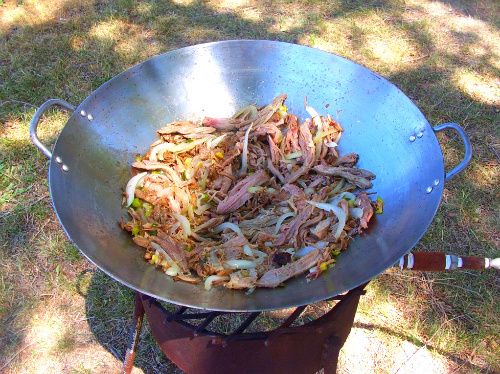EXCELLENT ARTICLE. Site Included.
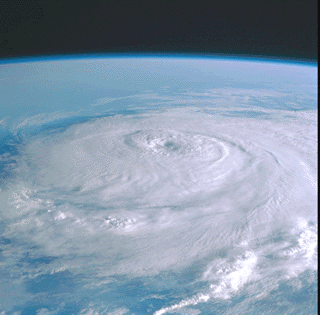
Disaster Survival Planning Checklist,
Emergency Preparedness Checklist,
Disaster Planning Checklist, and
Disaster Survival Checklist, v32
Your planning should see your family through a minimum of fourteen days of survival.Fourteen days will statistically see your family through 96% of known disaster emergency situations. Seven days will only get you through 50% of known disaster situation. Consider more than fourteen days of survival for locally known situations where your area can be physically cut off from resupply for very long durations (seismic areas, land/snow/mud slide areas, below sea level areas, flood planes, low lying island areas and areas of difficult or single method access, for example by bridge, single road, boat, plane, trail, or by horse/mule access only). The 2004 Florida Hurricanes had some home areas without power for up to 22 days, but the area residents had access to vehicles and could travel to other towns for supplies. New Orleans' Hurricane Katrina demonstrated the good and the bad for planning and preparation.
After the initial creation of this checklist, the Lowe's Severe Weather / Natural Disaster Readiness Guide and theAmerican Red Cross web page guides were used as references for content validation. By the way, this site holds up very well, perhaps presenting the most items and situational concerns, however, two issues exposed themselves over time: 1) There were, at one time, hypertext links to the Red Cross and Lowe's Emergency Planning Web Pages embedded in this checklist/web page, however both organizations kept changing their web page locations and names (URL's), so we stopped trying to track their shifting Web Site page URL's - their web pages are still good sources for information. 2) While the other sites list nearly the same checklist items, our site addresses big view issues and little situational issues and solutions that other sites don't write about.
As for personal experience: Dennis has been in several Hurricanes, a few Typhoons, Floods, Earthquakes, a Wild Fire, many Blizzards, and unknowingly survived driving near the edge of a Tornado during a dark and rainy night on a motorcycle (the same tornado that broke the back of Dennis' US Army Flight School Class Leader, Larry Rose, and destroyed three helicopters on the flight line). Dennis has also performed a few search and rescues (or recoveries) by Helicopter.
Some common events that result from natural disasters are:
1. Varying degrees of property loss/destruction:
- Loss of shelter (from slight to complete)
- Loss of land, vegetation, and/or resources
- Loss of protection from weather, heat, environment
(infection, diseases)
- Loss of Physical Security (human, creepy crawlers, and predators)
2. Loss of clean water:
- No drinking
- No bathing/shower
- No flushing
- No water for water heater
- No water for sanitizing
- No hot water
- No water for cleaning
- And maybe no water at all
3. Loss of food:
- Access
- Supply Contamination
- Spoilage
4. Loss of medical care and sanitation capabilities.
5. Loss of power source (electrical, fuel, steam, natural gas):
- Loss of light
- Loss of heat
- Loss of cooling
- Loss of ALL appliances
6. Loss of communication:
- Loss of telephone (cell and cellular phones too)
- Loss of TV
- Loss of radio (transmit or receive signal)
- Loss of satellite (wind, cloud, lightning, power
signal conversion, reception, or battery loss).
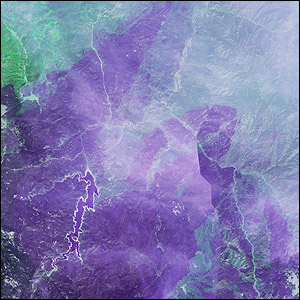 The idea behind natural disaster preparation is to "Be Prepared" for:
Utility Loss
Service Loss
Mobility Loss
Convenience Loss
Degrees of Property Damage and/or Loss
Residents of remote areas already know (or should know) that restoration will take longer, therefore some checklist items, like food, require a larger reserve inventory than in other areas.The following checklist is generalized for surviving known natural disaster types. Specific types of disasters will require specific types of active preparation. For example, in an area known for flooding, one should consider having a one way sewage valve that prevents sewage from reversing direction when the water treatment facility has a higher water/flood level than a residence. The Red Cross and some government agencies have further details about specific Natural Disaster Readiness. Again, our apologies for not having hyper links but the Red Cross keeps changing its web page name or location.
The idea behind natural disaster preparation is to "Be Prepared" for:
Utility Loss
Service Loss
Mobility Loss
Convenience Loss
Degrees of Property Damage and/or Loss
Residents of remote areas already know (or should know) that restoration will take longer, therefore some checklist items, like food, require a larger reserve inventory than in other areas.The following checklist is generalized for surviving known natural disaster types. Specific types of disasters will require specific types of active preparation. For example, in an area known for flooding, one should consider having a one way sewage valve that prevents sewage from reversing direction when the water treatment facility has a higher water/flood level than a residence. The Red Cross and some government agencies have further details about specific Natural Disaster Readiness. Again, our apologies for not having hyper links but the Red Cross keeps changing its web page name or location.
Disaster Survival Planning Checklist,
Emergency Preparedness Checklist:
--------------------------------------------------------------
Prior Plans, Arrangements, and Actions
--------------------------------------------------------------
[ ] Short-Term and Long-Term plan for inadvertent separation,
Escape route plan and alternate plans for:
[ ] House Escape (e.g., meet at corner, church, school, ...)
[ ] Location Escape (e.g., meet at uncle's house in X City)
[ ] Address and Phone Numbers:
[ ] Pre Store: - A List/Photocopy of Important Numbers
[ ] In a waterproof protector/container
[ ] - Last year's Telephone Book
[ ] Make Handy and At Last Moment, Store:
[ ] - Personal/Family Address Book or List
[ ] - Current Local Telephone Book
[ ] - Insurance Agent(s)
[ ] - Insurance Company(ies)
[ ] - Policy(ies) in known safe place
[ ] Important Home Documents (Kept in sealed water proof
box/containers/document-holders, which in turn are stored
inside a fireproof safe, gun safe, or fireproof file cabinet):
Check Books, Birth Certificates, Pass Ports, Visas,
Mortgages, Loans, Ownership, Cash, other small valuables
[ ] Computer backup system that is restorable -
Computer/Data Information Disaster Recover Plan
[ ] Emergency Cash. There is often a time frame when cash is
unavailable, even if you have money in the bank and a dozen
credit cards. When money systems are temporarily not
working, cash can become a scarce and valuable commodity.
--------------------------------------------------------------
Items and Issues
--------------------------------------------------------------
[ ] Large Plastic Trash Can(s), with Wheels and Cover
used to store the Disaster Supplies,
40 to 55 Gallon, No holes (leak proof / floatable).
- If New and Clean, It may be lined and filled with water.
- It is difficult to get liners larger than 55 gallon
size (found in hardware stores) - Meaning that larger
containers loose any water storage benefit.
[ ] Plastic Sheeting (NOT the super thin cheap stuff,
big roles (found in paint supplies), 75 yards
[ ] Duct Tape, 150-175 yards (NOT masking tape)
[ ] Flashlight(s) and Batteries, Tested and Working.
Observation 1: All family members feel tremendously more
secure if they have their own flashlight, even if its
an LCD light for a two year old.
Observation 2: Lately the expensive self contained
perpetual electric generation by motion or crank lights
seem to be worth consideration. There appear to be two
versions, as some have very dull lighting and some are
very bright - test before purchasing. Know the
usage instructions.
[ ] Matches/Lighter, Dry, with reserve Fuel, Water Proof
Container. Usually when these are needed there is 100%
humidity, everything is wet, and the wind is blowing.
Wind Proof Butane lighters work well below 7,000 Feet
Altitude. Magnesium Strikers work all the time,
anywhere (not cheap, makes ignition spark, not flame).
Matches and Waterproof Matches are less reliable in
bad weather conditions. A mix is best.
[ ] Oil burning Lamps/Lanterns. Extra oil, maybe a few spare wicks
and/or glass bulbs. Oil wicks dry out and any un-used oil in the
lantern base will evaporate over time. Wicks may need to be
re-primed with a little oil - be careful, there is a reason
that oil lamps are not used much any more - any oil-lamp
mismanagement is a fire hazard.
Warning: Do NOT leave kids, animals, or mentally
challenged people around burning lamps.
Warning: Do NOT leave lamps on table cloths or
similar conveyances as they may be pulled off and start
a fire too easily.
[ ] Fire Extinguishers, quantity 2 x 10-20 Pound,
ABC Type Rating (only and always)
[ ] Candles, Many, Long Burn Time is Best. Learn to save
all candles accumulated over time in a candle (shoe) box.
Warning: There are times when using candles/oil lamps
is a safety hazard (presence of: natural gas, dust/small
particles, chemical agents, anything that can burn
or explode; also kids, pets, and wind or loose materials
create additional safety issues).
Warning: Do NOT leave candles unattended and
their benefit is for after the disaster,
NOT during the disaster.
[ ] Batteries for all existing battery operated equipment
(Look through this list for any reminders)
[ ] First Aid Kit, See First Aid (Group/Family) Kit
Communication Considerations - Make reasonable choices:
[ ] Device Batteries and Spares, Fully Charged,
[ ] Gather the Battery Charging Units (House and Automobile)
Note:-Sometimes people live off generator and automobile
charged battery systems for weeks.
-Sometimes the generator is located at a friends,
church, business establishment.
Two Way Communication Units:
[ ] Cell Phone, Satellite Phone
[ ] CB Radio and or base station (system)
[ ] CB/2 Meter/Ham Transmitter (Requires Power System,
Antenna System, and prior knowledge/training/and
a License to operate) This may be a neighbor.
Don't forget the Internet (when available).
One Way Communication Units:
[ ] AM/FM portable radio, Short Wave Receiver
[ ] Radio (batery operated, also with AC is better)
with shortwave reception is best, digital and analog
[ ] TV (batery operated, also with AC is better)
analog and digital signal capable
[ ] Insect Repellent:
[ ] DEET
Permethrin (requires wash or spray application to clothing prior to use,
not for human skin application, it is for Clothing ONLY,
will kill cats but not dogs, for example if cats
lie on a shirt or coat that was dipped in a
Permethrin solution
Water & Container considerations:
[ ] Fill Tubs (Most likely used for cleanup,
but can be treated and drank. Assumes clean
environment to start and water boiled for 5 minutes
and/or chemical treated [Read treatment instructions.
If Clorox, non scented and non soapy,
one drop per liter/quart or five drops per gallon,
mix and let set for at least five minutes]).
All water treatment requires boiling.
[ ] Bottled Water:
- Refill sanitized bottles (grape, apple, water) over time.
- Buy bottled water by the case (plastic or glass).
Consider bottled/canned non refrigerated Juices too.
[ ] Best: Large Construction Site Plastic Water Jugs
with a side tap (not cheap, at least one,
20 to 30 gallon. Fill it where it will be stored
by hose, pitcher, or water cans.
[ ] Plastic Water Bladders, Water Cans (3 to 5 gallon,
Many, Plan One Gallon per Person per Day minimum,
more if working or other known local situation)
[ ] Sustenance (NON Refrigerated):
Canned:
[ ] Stew, Beans, Meat, Fish, Peanut Butter, Other Protein
[ ] Vegetables
[ ] Milk
[ ] Soup
[ ] Juice
[ ] Survival or Camping Prepackaged Meals
Caution: Most Prepackaged Meals Require Water
Plastic:
[ ] Gatorade (powder or liquid form)
Caution: Powdered mixes require water.
Fuel:
[ ] Vehicle(s) topped off, and Road Ready. Consider
Evacuation, where/when appropriate.
See Vehicle & Travel Checklists
[ ] Plastic Fuel Containers, Appropriate, Correct Fuel Type,
Safely Stored. Fuel can be a hazard if not
properly protected, mostly used for your generator)
(Metal cans rust, full cans prevent water condensation)
[ ] Propane Fuel Bottle(s), Full
[ ] Optional: Fuel Hose or Fuel Siphoning System
Warning: Don't get yourself into a situation
where you may be considered to be a looter,
know your neighbors, work with friends
[ ] Generator, Topped off with Gasoline and Oil.
Trade off exists between Size (Watts) and Fuel Use.
Generally, the bigger the better, bigger units use
more fuel. Best Case: 1800 Watt and a 5000 Watt.
5000W stays stationary, 1800W ported for tool use.
Not to be used in a home or enclosed space,
Read the operators manual, know appliance Watt ratings.
DO NOT Connect to the house current, plug appliance
into extension cord.
Note: Propane Generators also exist but are
only worth consideration if you have access to a
very large propane fuel reserve source.
[ ] Extension Cords: 50 Ft, Heavy Duty, 4 to 8 count
[ ] Stove/Grill: White Gas, Propane, and/or Charcoal,
Camping type. Propane seems more utilitous with
10 and 20 pound bottles (which can be used for other
items). The system is most utilitous if it can also
function from the 1 pound bottles (which are commonly
sold in "sporting goods" departments or stores).
Caution Keep bottles current as they expire by
law (propane suppliers/dealers know the requirements).
[ ] Propane Lantern that can run from the same fuel tank
as stove cooking system and/or from little one pound
fuel bottles. Use a "tree or gang" hose outlet
(mantels, wrench, hoses). See Propane (Cook Station) details.
[ ] Refrigeration/Cooler/Ice (mix solutions if possible):
- Pre set all refrigerators or freezers to coldest setting.
- Open as little as possible.
[ ] Mini Electric or Propane Operated Refrigerator,
Combination Electric and Propane is best.
[ ] Cooler(s): Bigger is better, more than one if possible
(coolers usually can float, if necessary)
[ ] Ice: If you have a freezer, use the freezer as a cooler.
Pre-Freeze blocks of ice in plastic bags and/or buy
(Ice can be a very valuable commodity)
[ ] Bow Saws: One 3-4 Foot Blade, One 2 Foot Blade,
Spare Blades.
[ ] Face Masks, Disposable
[ ] Trash Bags (2 boxes Kitchen size, and 1 box/roll
of Lawn/55 Gallon Drum sized)
[ ] Zip Lock type Plastic Baggies (Gallon and Quart)
[ ] Safety Goggles or Safety Eye Shield(s)
[ ] Plastic Buckets (5 gallon size, 3-5 count)
[ ] Sponges, Big (size of 2 fists of 1 big male, 3-5 count)
[ ] Bleach (pure bleach, NOT the color fast stuff),
used for sanitizing.
[ ] Towels (Lots of Paper and Cloth)
[ ] Knives (HD Swiss Type & HD Survival Type)
[ ] Baby Needs
[ ] Baby Wipes / Handy Wipes, These are very utilitous for
individual cleanup (like a bath in a box)
[ ] Kids Fear Note: When I was a small kid, I don't ever remember
being scared of a natural disaster in the making. I can remember
the family being huddled up together and sort of camping in the
basement or living area. What this really means is that my
parent(s) were acting calm and collected!
[ ] Kids:
[ ] Coloring Books/Paper, Crayons
[ ] Reading Books (parents too)
[ ] Paper, Pencils, Color Pencils
[ ] Little Job Responsibilities (putting pictures in
albums, Memorizing the States/Capitols/Presidents.
[ ] Can Opener, Manual (Knives and P38's get old in a hurry)
[ ] Camera, working, with Film (Disposable Camera can be stored)
Take pictures of the immediate after disaster effects
before restoration/clean up work begins, especially
for Insurance purposes.
[ ] Soap (bar and dish liquid). Personal Hygiene is Very
Important. Soap is the #1 Bacteria Killer. It
usually only takes three days for anciently known
germs and diseases to make an appearance somewhere.
[ ] Disinfectant
[ ] Toiletry Kit(s): See Toiletry
[ ] Including Sewing Kit
[ ] Work Gloves, Enough for Family and Friends (wink)
Clothing:
[ ] Good Heavy Duty Work Clothes, Changes of Clothing
[ ] Undies and Good Work Socks
[ ] Heavy Duty Boots
[ ] Wide brim hat(s)
[ ] Eating Ware (the idea is sanitation disposability
in an area where water is not readily available,
otherwise use your regular eating ware):
[ ] Paper Plates
[ ] Paper Cups
[ ] Plastic Eating Ware / Cutlery
Review Basic Foods and/or
Cooking Ware
[ ] Aluminum Foil, Heavy Duty, Wide (quite utilitous)
[ ] Medications: It is wise to have a list and schedule
of medications for each person. Some Meds require
special cooling or handling.
[ ] Use plastic bags and mark them as needed
[ ] Paper and Pencils
[ ] Water Proof Markers, Lots
[ ] Toilet Paper, Lots
[ ] Paper Towels, Lots
[ ] Pet Food and Water Considerations
Camping Equipment (See Camping as reminder):
[ ] Tent and associated gear
[ ] Sleeping Bags
[ ] Stove, Working with all Pieces present, Fuel
[ ] Blankets / Space Blankets
[ ] Matress/Pads
[ ] Chain Saw, Spare Chains, Oil, Lube Grease, Keys/Wrenches, Spark Plug,
Gasoline (in container). See Chain Saw
[ ] Axe(s)
[ ] Cordless Drills (charged, spare battery),
Drill Bits, Screw Bits (+ & -), Hex Bits,
(Torx bits if needed)
[ ] Screws: Assortment (boxes) of Phillips (+) Round Head
size 8, 10, & 12 at lengths of 1, 1.5, 2, 3,
and a few 4 inches.
[ ] Hammer, Nails (boxes of flat heads, 1, 2, 3, and 4 inch)
[ ] Wrenches, Large, Medium, and Small
(for 1/4 inch to 3 inch nuts)
[ ] Pliers (Large & Medium)
[ ] Scissors, Big (Box Cutter in a pinch)
Levers (Heavy Duty blown down work - AVOID Electrical Lines):
[ ] Crow Bar, Long (3 foot)
[ ] 6 foot long, 2 inch wide steel pipe
[ ] Wood 6 foot 2x4 or 4x4 inch post, no knots
(does not conduct electricity or transmit heat)
Ladders (AVOID power lines! - Read Safety Instructions):
[ ] 6 Foot Step Ladder
[ ] 24-34 Foot Extension Ladder
Wood:
[ ] Minimum of 8 to a bundle: 8 foot long knot free 2x4's,
[ ] Minimum of 2: 4x8 foot sheets, 3/8 inch thick
[ ] Other lumber as needed/desired
[ ] Nylon Rope and Tow straps, for Dragging and other Heavy
Duty work, (Strength measured in Tons, not Pounds)
Shovels:
[ ] 1 Long Flat Blade
[ ] 1 Long Spade (pointed) Blade
[ ] 1 Snow Shovel (with a long tine rake, works surprisingly
well for muddy and wind blown debris.
Like a huge dust pan!)
[ ] Mops, Brooms
Rakes:
1 Metal (Heavy Duty)
1 Long Tine (Plastic or Metal)
[ ] Cleaning supplies (buckets, soap, sponges, towels,
Heavy Duty Rubber or Latex Gloves)
[ ] Wet/Dry Vac
[ ] Wheelbarrow, Big, Working, Airless Tires best for this
situation. If pneumatic front Tire, then fill with
correct air pressure. Tire Pump, Flat Tire Repair Kit, Tube
[ ]
--------------------------------------------------------------
Other Considerations
--------------------------------------------------------------
[ ] The second most common disaster regret (after life
and death issues) is the loss of Pictures and
Photo Albums. Consider a storage/relocation plan.
This is a good responsibility for kids.
[ ] Neighbor/Family Check/Support/Report System
[ ] Livestock Safety
[ ] Pet ID, vaccination, photos, papers, carrier,
Keep close for evacuation
[ ] Consider investing in a total propane backup system
(4+ propane bottles [20 pound], stove, lamp,
mini refrigerator [about .5 bottle used per day
with mini-refrigerator])
[ ] House Standby Generator
[ ] Pipe Heaters, Wood Burning Stove, HD Hair Dryers
[ ] People Shelter - Safe Area Creation/Designation
and Reinforcement
[ ] Safe Fire Clearing Around House (including
firewood storage way away from house or
building), ability to seal up a house,
Fireproof a house
[ ] Waterproof a house, Earth dam walls,
Dwelling Elevation.
[ ] Sand Bags (a temporary solution),
Landscaping (a permanent solution)
[ ] Water Purifier. Hand operated, expedition type,
Typically available through better camping
supply stores, read instructions, have extra
filter cartridges.
[ ] Windproof/Stormproof a house (pre made window
coverings with fast connect/disconnect bolt
system)
[ ] Emergency fire fighting system (small trailer
with water tank, generator, pump, hose
fire suppressant chemical <- they work!!!)
[ ] Big Fans
[ ] One way sewage flow valve
[ ] Plan for gathering and storing loose
outdoor/lawn items - a good responsibility for kids.
[ ] Document Storage (Waterproof/Fireproof containers,
Complete Offsite Way Away Remote Digital Storage)
[ ] Plan for shutting down utilities, quickly
[ ] Earthquake Proofing (lots to do here, research online)
Also see Earthquake Survival, the Next Checklist.
[ ] Spare Circuit Breakers
Alternate Transportation:
[ ] Bicycles, See Bicycle
[ ] Small Boat, Canoe, Inflatable Raft
with oars/paddles & gear. See Boat
[ ] ATV, See ATV
[ ] Snow Mobile (Slang: Sled)
[ ] Various Sized, Stackable, Sealable Plastic Storage Boxes
[ ]
Comment: During the 2004 Florida Hurricane Season, guys and gals with chain saws were public hero's and Movie Theaters were a place to escape the heat (even if a movie was watched for the umpteenth time). A lot of Theater owners lowered the price of admission. People with working toilets were popular and toilet paper was more valuable than cigarettes in a prison.
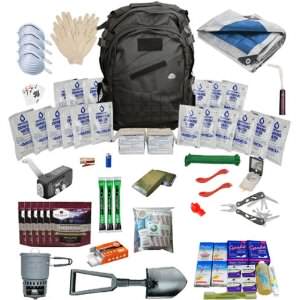





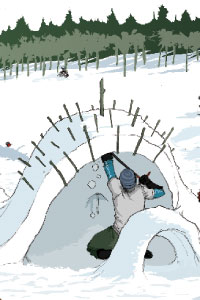
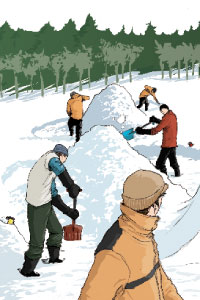 BUILDING A QUINZEE
BUILDING A QUINZEE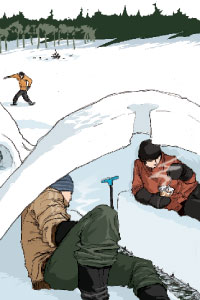 Step 3: Use the last foot of snow to make elevated snowbeds. Dig a narrow trench between the beds all the way to the ground. This allows cold air to flow down and out of the quinzee. Poke a small ventilation hole near the top of the dome.
Step 3: Use the last foot of snow to make elevated snowbeds. Dig a narrow trench between the beds all the way to the ground. This allows cold air to flow down and out of the quinzee. Poke a small ventilation hole near the top of the dome.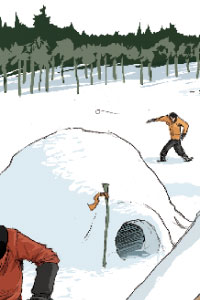 Step 4: Building a quinzee will make you sweat. Prevent hypothermia by changing into warm dry clothes after you finish building your shelter.
Step 4: Building a quinzee will make you sweat. Prevent hypothermia by changing into warm dry clothes after you finish building your shelter.





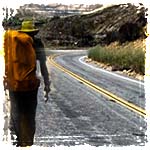







.jpg)


